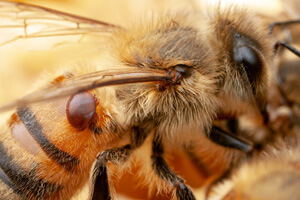
Varroa mites. Viruses. For the past several decades, beekeepers have sought to protect their colonies from these two ubiquitous threats that often come together. Not only do varroa mites weaken individual bees by feeding on their fat bodies, they also transmit diseases such as Deformed Wing Virus (DWV).
As everyone reading this column knows, unfortunately beekeepers have limited tools to combat varroa and viruses. We have a couple acids, some essential oils, IPM practices, and a couple synthetic chemical pesticides. To add insult to injury, we know that varroa is already evolving resistance to the synthetic chemicals. So, it’s very exciting news that groundbreaking research was just published on a new genetic approach to combat varroa and viruses. In this month’s Notes from the Lab, we highlight “Engineered symbionts activate honey bee immunity and limit pathogens,” published in the journal Science and authored by Sean Leonard and colleagues at the University of Texas at Austin. Leonard is a PhD student currently working in Dr. Nancy Moran’s lab.
For their study, Leonard and colleagues genetically modified naturally-occurring gut bacteria in honey bees to “teach” the bee immune system to recognize and destroy viruses and the varroa mite. They did this by engineering microbes that, once accepted by the host bees, changed bee gene expression and immunity via the production of RNA interference (RNAi) molecules.
What does that mean, exactly? Well, RNAi is an important component of the immune system of most animals, including bees and varroa mites. In short, the immune system detects double stranded RNA (dsRNA) molecules, which are produced by viruses (e.g., dsRNA is produced by DWV). Because the dsRNA molecules are an indicator of disease, an immune response is launched to detect and destroy the invaders. The honey bee immune system “learns” the genetic code of that dsRNA molecule and then targets all other molecules with that same genetic code for destruction.
Your immune system (or a bee’s immune system) can also be primed so a more effective immune response can be launched (think about those flu shots you get each fall to reduce your chances of getting sick). It had been previously shown that feeding DWV-specific dsRNA to bees prior to exposure to the virus increased lifespan and reduced virus levels in infected bees — suggesting that RNAi could be effective at “silencing” these viruses (Desai et al. 2012). However, the challenge is providing a constant source of dsRNA to honey bees that targets the full range of viruses that infect the bees.
This is where Leonard and colleagues’ study really breaks ground. Instead of constantly feeding honey bees dsRNA molecules directly, the authors engineered the naturally occurring bacteria in the bee gut to create dsRNA molecules. Specifically, they genetically engineered one gut bacterium, Snodgrassella alvi (S. alvi), to continuously produce dsRNA molecules that prime the honey bee immune system to target DWV and varroa.
But first, the researchers had to ensure that genetically transformed S. alvi could survive in the bee gut and produce molecules that would be taken up by bee tissues. To do this, they fed bees S.alvi that had been genetically modified to produce “non-target” dsRNA molecules as proof of concept. They found these dsRNA molecules were present in the head, gut, and hemolymph of bees, indicating the molecules were being circulated beyond where the bacteria reside in the gut. Also, the molecules were detected in bee tissues until the end of the 15-day experiment, indicating the dsRNA-producing S. alvi were self-sustaining in the bees. Moreover, the genetically modified S. alvi strains were shared through social interactions between co-housed bees. Thus, it is possible that only a subset of bees need to be exposed to the bacteria for it to establish in an entire colony (more on this later).
OK, so we’ve got bees with genetically enhanced gut bacteria producing dsRNA molecules that are able to reach all parts of the bee and remain present for over two weeks. Now, how can this technology be used to protect bees? The next step was using this tool to target viruses and varroa. Deformed Wing Virus is a widespread RNA virus and infections cause wing deformity and reduced lifespans in workers. “Silencing” DWV and other viruses via RNAi has been proven to improve bee….


